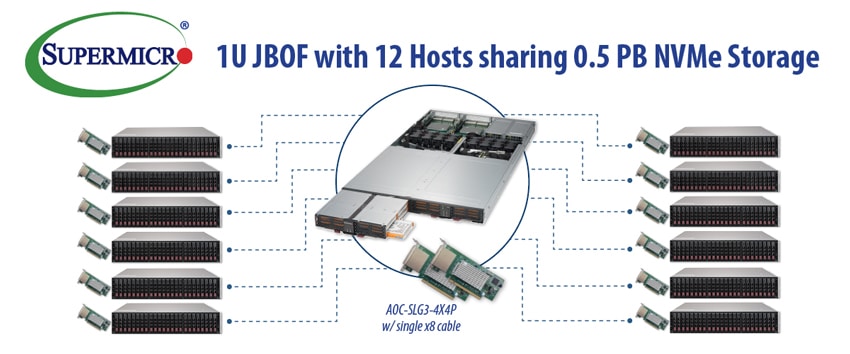 Today Super Micro Computer, Inc. announced its latest Rack Scale Design (RSD), version 2.1, now with pooled all-flash NVMe composable storage support. This new pooling ability can bring Peta-scale NVMe storage that is shared by up to twelve hosts. This would be ideal for applications such as high throughput ingest, HPC, data analytics, video streaming, CDN, and software-defined storage (SDS) environments.
Today Super Micro Computer, Inc. announced its latest Rack Scale Design (RSD), version 2.1, now with pooled all-flash NVMe composable storage support. This new pooling ability can bring Peta-scale NVMe storage that is shared by up to twelve hosts. This would be ideal for applications such as high throughput ingest, HPC, data analytics, video streaming, CDN, and software-defined storage (SDS) environments.
Today Super Micro Computer, Inc. announced its latest Rack Scale Design (RSD), version 2.1, now with pooled all-flash NVMe composable storage support. This new pooling ability can bring Peta-scale NVMe storage that is shared by up to twelve hosts. This would be ideal for applications such as high throughput ingest, HPC, data analytics, video streaming, CDN, and software-defined storage (SDS) environments.

Based off of Intel’s RSD, Supermicro’s version serves a similar purpose: allowing customers to manages racks of disaggregated servers, storage, and networking. RSD uses industry standard Redfish Restful APIs that remain consistent across different vendors and multiple server generations. The latest version now supports NVMe storage that in turn will lead to improved datacenter efficiency. The RSD 2.1 is also based on Intel’s RSD 2.1 specification, and according to the company marks the beginning of a paradigm shift to deploy truly disaggregated resource pools in large-scale data centers that dramatically improve datacenter efficiency, increase utilization and reduce costs.
Supermicro’s RSD 2.1 will all run on its X11-generation server and storage systems supporting Intel Xeon Scalable processors as well as Supermicro X10-generation server and storage systems supporting the Intel Xeon processor E5-2600 v4 family. RSD 2.1 is tightly integrated with other datacenter management software layers such as OpenStack. This, combined with the new NVMe storage, will allow organizations to scale up datacenter efficiently and more cost-effectively while gaining even more flexibility.
Key features include:
- An interactive dashboard that provides the datacenter administrators an overview of all physical assets under RSD management
- An interactive, topological view of the physical rack and chassis in the Supermicro Pod Manager UI. Administrators can further select chassis in the rack to drill down on details at the component level such as BMC IP address, physical position in the rack and related capabilities.
- Analytics and telemetry about system overview, utilization, CPU, memory and composed nodes. The historical data will not only help users understand how their systems were used but also predict possible future system behaviors.
Sign up for the StorageReview newsletter
